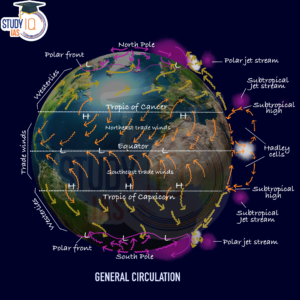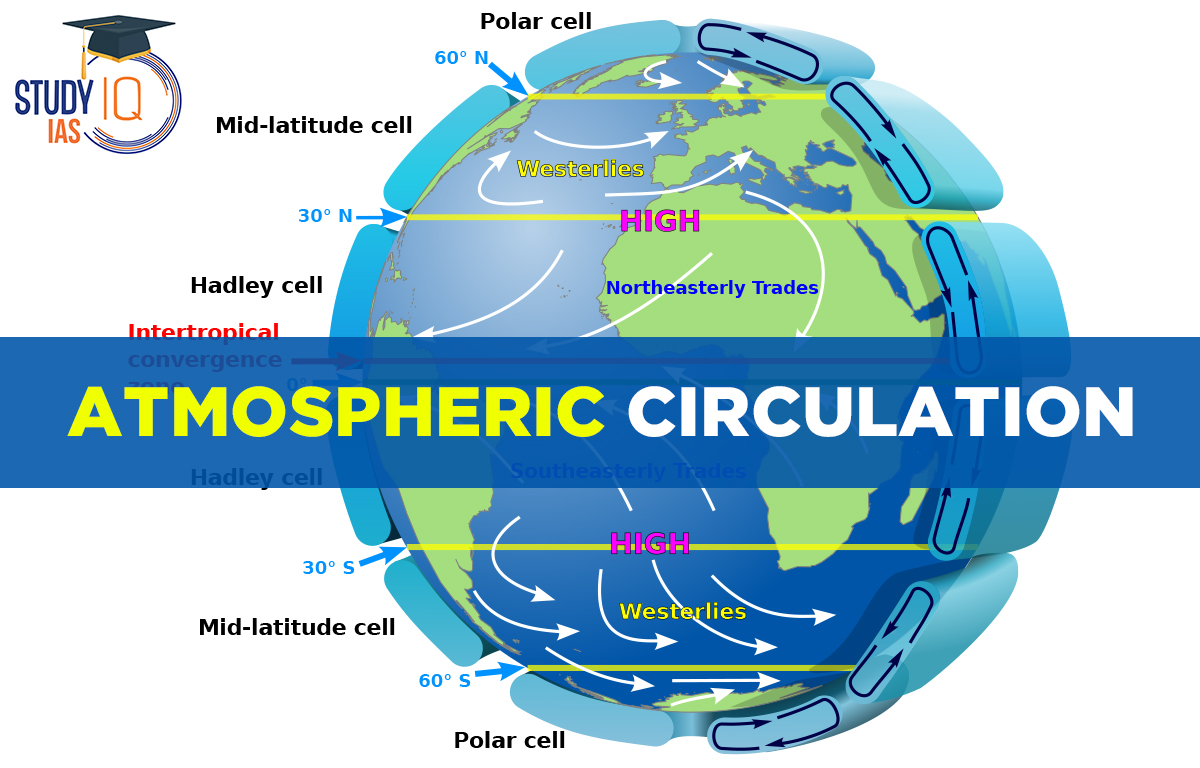Table of Contents
Atmospheric Circulation
Solar radiation reaches the Earth and passes through the atmosphere, where it is absorbed or reflected. Most of this heat is absorbed by the Earth’s surface warming the land and water. A small amount of heat from the surface is transferred to the air above through conduction but air is a poor conductor because its molecules are spread out. Most heat in the atmosphere moves by radiation and convection. When sunlight warms the Earth’s surface, that heat is re-radiated into the atmosphere warming it from the bottom up. Greenhouse gases absorb and re-radiate this heat, creating the greenhouse effect. Warm air expands, becomes less dense, and rises, while cooler air sinks to replace it. This movement of air creates wind and is known as convection.
Around the tropics, convection patterns occur because the equator gets more sunlight than higher latitudes, forming air masses called Hadley Cells that move heat and moisture toward the poles. Air movement is also influenced by the Earth’s spin, which causes the Coriolis effect, making air travel in curved paths instead of straight lines. The layout of continents, oceans, and mountains adds more complexity to these patterns. Different surfaces absorb sunlight and re-radiate heat differently. For example, land heats up and cools down faster than water, causing sea breezes to blow from the ocean to the land during the day and from land to sea at night.
Atmospheric circulation moves heat across the Earth affecting the water cycle, weather, and climate. Ocean currents, pushed by wind, also transport heat globally. Human activities that enhance the greenhouse effect are changing these circulation patterns, impacting environments around the world.
Read More: Monsoon in India
Atmospheric Circulation Three Model Cells
Each hemisphere’s Atmospheric Circulation is made up of three cells. The Hadley cell, the Polar cell, and the Ferrel cell are three types of cells. Each circulation cell makes one complete circuit around the Earth each year.
1. The Hadley cell
The Hadley cell is a large-scale atmospheric circulation in which air rises near the equator flows poleward at a high altitude, descends in the subtropics, and then flows equatorward near the surface.
2. The Ferrel cell
The Ferrel cell is a mid-latitude atmospheric circulation in which air rises in the subtropics, flows poleward at a high altitude, and then descends in the mid-latitudes.
3. Polar Cell
In low-latitude atmospheric circulation, air rises near the equator, flows towards the poles at high altitudes, and then sinks in subpolar regions. There are three main atmospheric circulation cells. The Hadley cell moves warm air and moisture from the equator to the mid-latitudes, helping to create precipitation. The Ferrel cell carries cold air from the mid-latitudes to the poles, contributing to sea ice formation. The Polar cell moves warm air from the poles to the mid-latitudes, which also helps with precipitation.
Read More: Jet Streams
General Atmospheric Circulation
The wind is the result of a pressure gradient caused by the differential heating of the earth. Winds in the atmosphere do not follow the same pattern as we go up in the atmosphere. In fact, winds may change their direction and intensity multiple times within the same day. Wind movement in the atmosphere can be classified into three broad categories:
| Classification | Details |
| Primary Circulation | It includes planetary wind systems, which are related to the general arrangement of pressure belts on the earth’s surface. The primary circulation patterns prepare the broad framework for the other circulation patterns. |
| Secondary Circulation | It consists of cyclones and anticyclones, monsoons etc. |
| Tertiary Circulation | It includes all the local winds produced by local causes such as topographical features, sea influences, etc. Their impact is visible only in a particular area. |
Read More: Types of Winds
General Atmospheric Circulation Diagram
We are providing with you a General Atmospheric Circulation Diagram below:

Read More: Pressure Belts
Atmospheric Circulation & Direction of Movement of Wind
Insolation is the main cause of wind. All winds start from the same process. Different parts of the Earth heat unevenly, creating temperature gradients that lead to pressure gradients. These gradients make air move. Wind is nature’s way of balancing out uneven air pressure across the Earth’s surface, usually flowing from high-pressure areas to low-pressure areas. However, factors like Earth’s rotation and friction can affect this flow.
The direction of wind movement is determined principally by the interaction of three factors: the pressure gradient, the Coriolis effect, and friction. The speed of wind flow is determined primarily by the pressure gradient, though the frictional force plays a significant role in slowing down the wind. The air accelerates swiftly if the gradient is steep and the acceleration is slow if the gradient is gentle.
Surface winds are relatively gentle over most of the world most of the time. Wind speed also varies depending on the altitude. It is quite variable from one altitude to another and from time to time. It usually increases with height. Winds tend to move faster above the friction layer.
Read More: List of Major Local Winds
Atmospheric Circulation Factors
1. The Sun
Sun is the ultimate source of all forces that propel wind causing unequal heating of the earth’s surface. This plays a major role in determining the speed and movement of the wind.
2. Pressure Gradient
Air moves from areas of high pressure to areas of low pressure due to the pressure gradient force. This means that where there’s a big difference in pressure, air will flow toward the lower pressure. The pressure gradient is stronger when isobars (lines on a map showing equal pressure) are close together, which means stronger winds. When isobars are farther apart, the pressure gradient is weaker, resulting in lighter winds. The wind moves in the direction of the pressure change, which is perpendicular to the isobars.
Read More: Atmospheric Pressure
Atmospheric Circulation UPSC
Atmospheric circulation is an important factor in determining a location’s weather conditions. It aids in the exchange of heat and moisture between various parts of the atmosphere. It also has an impact on the distribution of precipitation. A variety of factors influence atmospheric circulation, including temperature and pressure gradients, Coriolis force, and friction. This topic holds immense importance for the UPSC exam and an aspirant should be well aware of this topic.


 Story of Meera Bai and Her Devotion For ...
Story of Meera Bai and Her Devotion For ...
 Desert Climate, Distribution, Climatic C...
Desert Climate, Distribution, Climatic C...
 Deserts of India Map, Features of Thar D...
Deserts of India Map, Features of Thar D...





















